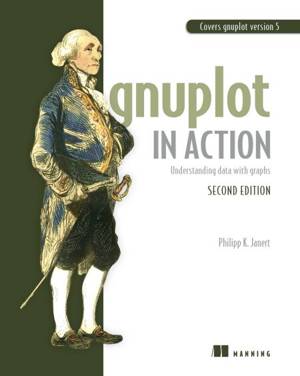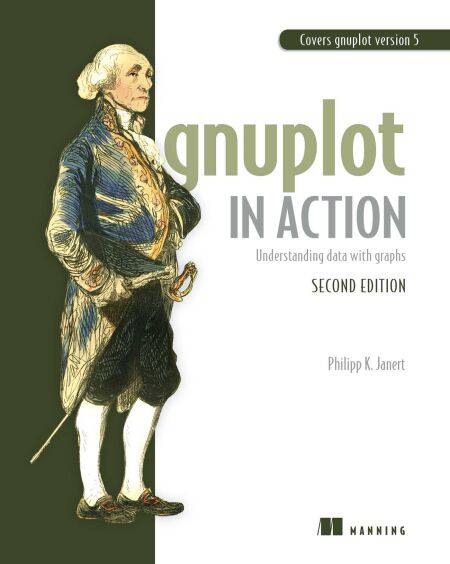
- Retrait gratuit dans votre magasin Club
- 7.000.000 titres dans notre catalogue
- Payer en toute sécurité
- Toujours un magasin près de chez vous
- Retrait gratuit dans votre magasin Club
- 7.000.000 titres dans notre catalogue
- Payer en toute sécurité
- Toujours un magasin près de chez vous
39,13 €
+ 39 points
Format
Description
Summary
Gnuplot in Action, Second Edition is a major revision of this popular and authoritative guide for developers, engineers, and scientists who want to learn and use gnuplot effectively. Fully updated for gnuplot version 5, the book includes four pages of color illustrations and four bonus appendixes available in the eBook.
Purchase of the print book includes a free eBook in PDF, Kindle, and ePub formats from Manning Publications.
About the Technology
Gnuplot is an open-source graphics program that helps you analyze, interpret, and present numerical data. Available for Unix, Mac, and Windows, it is well-maintained, mature, and totally free.
About the Book
Gnuplot in Action, Second Edition is a major revision of this authoritative guide for developers, engineers, and scientists. The book starts with a tutorial introduction, followed by a systematic overview of gnuplot's core features and full coverage of gnuplot's advanced capabilities. Experienced readers will appreciate the discussion of gnuplot 5's features, including new plot types, improved text and color handling, and support for interactive, web-based display formats. The book concludes with chapters on graphical effects and general techniques for understanding data with graphs. It includes four pages of color illustrations. 3D graphics, false-color plots, heatmaps, and multivariate visualizations are covered in chapter-length appendixes available in the eBook.
What's Inside
Creating different types of graphs in detail Animations, scripting, batch operations Extensive discussion of terminals Updated to cover gnuplot version 5
About the Reader
No prior experience with gnuplot is required. This book concentrates on practical applications of gnuplot relevant to users of all levels.
About the Author
Philipp K. Janert, PhD, is a programmer and scientist. He is the author of several books on data analysis and applied math and has been a gnuplot power user and developer for over 20 years.
Table of Contents
PART 1 GETTING STARTED Prelude: understanding data with gnuplot Tutorial: essential gnuplot The heart of the matter: the plot command PART 2 CREATING GRAPHS Managing data sets and files Practical matters: strings, loops, and history A catalog of styles Decorations: labels, arrows, and explanations All about axes PART 3 MASTERING TECHNICALITIES Color, style, and appearance Terminals and output formats Automation, scripting, and animation Beyond the defaults: workflow and styles PART 4 UNDERSTANDING DATA Basic techniques of graphical analysis Topics in graphical analysis Coda: understanding data with graphs
Gnuplot in Action, Second Edition is a major revision of this popular and authoritative guide for developers, engineers, and scientists who want to learn and use gnuplot effectively. Fully updated for gnuplot version 5, the book includes four pages of color illustrations and four bonus appendixes available in the eBook.
Purchase of the print book includes a free eBook in PDF, Kindle, and ePub formats from Manning Publications.
About the Technology
Gnuplot is an open-source graphics program that helps you analyze, interpret, and present numerical data. Available for Unix, Mac, and Windows, it is well-maintained, mature, and totally free.
About the Book
Gnuplot in Action, Second Edition is a major revision of this authoritative guide for developers, engineers, and scientists. The book starts with a tutorial introduction, followed by a systematic overview of gnuplot's core features and full coverage of gnuplot's advanced capabilities. Experienced readers will appreciate the discussion of gnuplot 5's features, including new plot types, improved text and color handling, and support for interactive, web-based display formats. The book concludes with chapters on graphical effects and general techniques for understanding data with graphs. It includes four pages of color illustrations. 3D graphics, false-color plots, heatmaps, and multivariate visualizations are covered in chapter-length appendixes available in the eBook.
What's Inside
Creating different types of graphs in detail Animations, scripting, batch operations Extensive discussion of terminals Updated to cover gnuplot version 5
About the Reader
No prior experience with gnuplot is required. This book concentrates on practical applications of gnuplot relevant to users of all levels.
About the Author
Philipp K. Janert, PhD, is a programmer and scientist. He is the author of several books on data analysis and applied math and has been a gnuplot power user and developer for over 20 years.
Table of Contents
PART 1 GETTING STARTED Prelude: understanding data with gnuplot Tutorial: essential gnuplot The heart of the matter: the plot command PART 2 CREATING GRAPHS Managing data sets and files Practical matters: strings, loops, and history A catalog of styles Decorations: labels, arrows, and explanations All about axes PART 3 MASTERING TECHNICALITIES Color, style, and appearance Terminals and output formats Automation, scripting, and animation Beyond the defaults: workflow and styles PART 4 UNDERSTANDING DATA Basic techniques of graphical analysis Topics in graphical analysis Coda: understanding data with graphs
Spécifications
Parties prenantes
- Auteur(s) :
- Editeur:
Contenu
- Nombre de pages :
- 400
- Langue:
- Anglais
Caractéristiques
- EAN:
- 9781638352778
- Date de parution :
- 07-03-16
- Format:
- Ebook
- Protection digitale:
- Adobe DRM
- Format numérique:
- ePub







